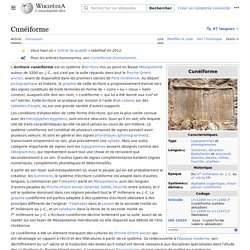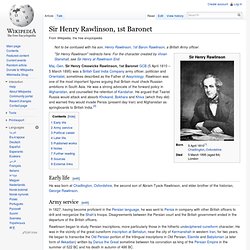

Cunéiforme. L’écriture cunéiforme est un système d'écriture mis au point en Basse Mésopotamie entre 3400 et 3300 av.

J. -C., qui s'est par la suite répandu dans tout le Proche-Orient ancien, avant de disparaître dans les premiers siècles de l'ère chrétienne. Au départ pictographique et linéaire, la graphie de cette écriture a progressivement évolué vers des signes constitués de traits terminés en forme de « coins » ou « clous » (latin cuneus), auxquels elle doit son nom, « cunéiforme », qui lui a été donné aux XVIIIe et XIXe siècles. Cette écriture se pratique par incision à l'aide d'un calame sur des tablettes d'argile, ou sur une grande variété d'autres supports. Les conditions d'élaboration de cette forme d'écriture, qui est la plus vieille connue avec les hiéroglyphes égyptiens, sont encore obscures.
Le cunéiforme a été un élément marquant des cultures du Proche-Orient ancien qui ont développé un rapport à l'écrit et des littératures à partir de ce système. Histoire[modifier | modifier le code] Sir Henry Rawlinson, 1st Baronet. Early life[edit] He was born at Chadlington, Oxfordshire, the second son of Abram Tyack Rawlinson, and elder brother of the historian, George Rawlinson.

Army service[edit] In 1827, having become proficient in the Persian language, he was sent to Persia in company with other British officers to drill and reorganize the Shah's troops. Disagreements between the Persian court and the British government ended in the departure of the British officers. Political career[edit] Rawlinson was appointed political agent at Kandahar in 1840. Serendipitously, he became known personally to the governor-general, which resulted in his appointment as political agent in Ottoman Arabia.
He was elected a Fellow of the Royal Society in February 1850 on account of being "The Discoverer of the key to the Ancient Persian, Babylonian, and Assyrian Inscriptions in the Cuneiform character. Henry C. Later life[edit] His views were more particularly expressed in England and Russia in the East (1875). Published works[edit] Robert John Braidwood. Robert John Braidwood (29 July 1907–15 January 2003) was an American archaeologist and anthropologist, one of the founders of scientific archaeology, and a leader in the field of Near Eastern Prehistory.

Life[edit] Braidwood was born July 29, 1907 in Detroit, Michigan, the first child of Walter John Braidwood (c1876) and Reay Nimmo (1881), and was educated at the University of Michigan, from where he graduated with an M.A. in architecture in 1933. Within a year he had joined the University of Chicago Oriental Institute's expedition to the Amuq Plain with the archaeologist James Henry Breasted. He worked with the expedition until 1938, during which time he married fellow Michigan graduate Linda Schreiber, who became his partner in the field and in his research.
Braidwood spent World War II working for the Army Air Corps, in charge of a meteorological mapping program. Robert John Braidwood died January 15, 2003 in Chicago. Work[edit] Further reading[edit] Sources and external links[edit]